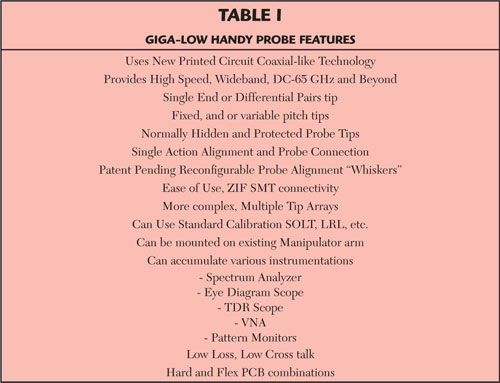
RFCONNEXT Inc. has developed a family of advanced high speed, wideband transmission lines, comprising patent pending PMTL™, VMTL™ and SMTL™, that provide new possibilities for cables and connectors, high speed PCB routing, electronic packaging interconnects, test and measurement probing, and RF/microwave and wireless communication applications. These advanced transmission lines are being embedded in many modern electronic components and systems to improve speed and bandwidth, using the traditional manufacturing processes. One of the applications of these transmission lines is the development of new probing technologies, as to provide high speed interconnects between the test instrumentation and the test point on the PCB, in the form of Single Ended and Differential Pairs tips, with the highest level of signal integrity.
Giga-Low Handy Probe™ provides a single action connection to unplanned or pre-planned surface-mount pads (SMT) or traces with a single action. The new product, while providing excellent electrical performance to 50 GHz and beyond (including clean, sharp edge TDR), eliminates the need for bulky and expensive xyz tables with mounting probes stations (see Table 1). It provides its own patent pending alignment “whiskers” that secures the probe to the strategic proximity of the test points SMT pads; a gentle push down of the Hand Probe exposes the otherwise hidden and protected tips of the probe and connects it to the SMT of the PCB under test. The full bandwidth, flex TEM transmission line practically eliminates the probe tip parasitic, while providing variable pitch Diff Pair testing capability.

Existing Handy Probes are limited to the use of coaxial line flexes to achieve similar bandwidth and traditional connectors, and present challenging interconnect issues in terms of Single Ended and Differential Pair connectivity. The Giga-Low Handy Probe uses the full bandwidth RFCONNEXT Giga-Low uFlex™, TEM flexible cable with advanced connector and interface technologies that provide ample flexibility and re-configurability to the PCB probing. One of the clear advantages is the provision of readily achievable SOLT and LRL and other types of calibration of the probe to the tips.

Another feature is the provision of reconfigurable tips, “whisker” alignment pins and other SMT configurations, with simple alignment holes on the PCB, providing many improvements for the PCB probing. Additionally, the Handy Probes can be designed with high speed connectors, such as 3.5, 2.92, 2.4, 1.85 and 1 mm, etc., or be provided with an integrated Giga-Low uFlex extension, or as a separate add-on. Either way, the use of PMTL technologies provides many possible configurations in printed circuit technologies that are impossible to achieve with the traditional methods and extruded coaxial lines. For example, with RFCONNEXT’s printed PMTL micro coax technology, an array of probe tips can easily be accommodated for more complex SMT probing, for manual or automatic operation (see Table 2).
The flexibility and re-configurability of the PMTL technologies provides many possibilities for improved PCB probing, for TDR, VNA, and SE and DP signal testing. In addition to manual operation, the Handy Probe can be mounted on traditional manipulating arms for full automatic testing.
RFConnext Inc.,
San Jose, CA
(408) 981-3700,
info@rfconnext.com,
www.rfconnext.com
RS No. 303
